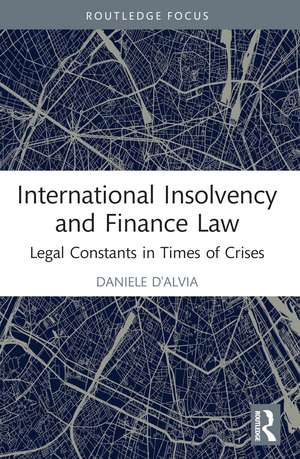International Insolvency and Finance Law: Legal Constants in Times of Crises: Insights on International Economic Law
Autor Daniele D'Alviaen Limba Engleză Paperback – 29 ian 2024
| Toate formatele și edițiile | Preț | Express |
|---|---|---|
| Paperback (1) | 155.43 lei 6-8 săpt. | |
| Taylor & Francis – 29 ian 2024 | 155.43 lei 6-8 săpt. | |
| Hardback (1) | 385.39 lei 6-8 săpt. | |
| Taylor & Francis – 17 ian 2022 | 385.39 lei 6-8 săpt. |
Preț: 155.43 lei
Nou
Puncte Express: 233
Preț estimativ în valută:
29.74€ • 31.14$ • 24.61£
29.74€ • 31.14$ • 24.61£
Carte tipărită la comandă
Livrare economică 05-19 aprilie
Preluare comenzi: 021 569.72.76
Specificații
ISBN-13: 9781032243795
ISBN-10: 1032243791
Pagini: 98
Dimensiuni: 156 x 234 x 17 mm
Greutate: 0.45 kg
Ediția:1
Editura: Taylor & Francis
Colecția Routledge
Seria Insights on International Economic Law
Locul publicării:Oxford, United Kingdom
ISBN-10: 1032243791
Pagini: 98
Dimensiuni: 156 x 234 x 17 mm
Greutate: 0.45 kg
Ediția:1
Editura: Taylor & Francis
Colecția Routledge
Seria Insights on International Economic Law
Locul publicării:Oxford, United Kingdom
Public țintă
PostgraduateCuprins
Introduction
Chapter 1 – The Times of Crisis Between Insolvency and Financial Law
1.1. The Legal Theory of Finance
1.2. The Global Financial Crisis
1.2.1 Risk and Uncertainty
1.2.2 The Role of the Law in Financial Crisis
1.2.3 The 2020 Unfolding Crisis: Covid-19
1.3 The Evolution of Corporate Insolvency Law Regimes
1.3.1 The Private and Public Divide in Insolvency Law
1.3.2 Contractarian and Out-of-law Approaches
1.4 Comparative Law as a Policy Making Instrument of "Out-of-law" Meanings
1.5 Conclusions
Chapter 2 – Legal Constants, and the Constant Outside of the Law
2.1 Theories of Comparative Law: the Law as "Input"
2.1.1 The Functions and Aims of Comparative Law
2.1.2 Comparative Law as a Tool for Studying (Legal) Meanings
2.2 Legal Constant(s)
2.2.1 The Constant(s) Outside of the Law and Legal Constant(s)
2.2.2 The development of Legal Constants in Commercial Law
2.3 The Uncofidied-Codification of the Law
2.3.1 The Uncodified Law and Crisis
2.4 Conclusions
Chapter 3 – The Un(codified) Financial Systems in Times of Crisis
3.1 The Ontology of Risk
3.1.1 The Epistemology of Risk
3.2 The Ontology of Uncertainty
3.2.1 The Role of Uncertainty
3.3 The Structures of Markets
3.3.1 The Financial Systems and Complexity
3.3.2 Competition and Financial Innovation
3.4 The New Legal Theory of Finance
3.4.1 The Un(codified) Role of Uncertainty
3.5 Conclusions
Chapter 4 – Cross-Border Insolvency Law: Venturing Beyond Structural Crisis
4.1 International Insolvency Law
4.1.1 The Role of Contract Law versus Statute Law
4.2 The Global Legal Indicators
4.2.1 The UNCITRAL Legislative Guide on Insolvency Law
4.2.2 The World Bank Principles for Effective Insolvency and Creditor/Debtor Regimes
4.2.3 The EBRD Core Principles of an Effective Insolvency System
4.3 The New Financial Architecture
4.3.1 Macro- Versus Micro-Legislations
4.4 Conclusions
Conclusions
Chapter 1 – The Times of Crisis Between Insolvency and Financial Law
1.1. The Legal Theory of Finance
1.2. The Global Financial Crisis
1.2.1 Risk and Uncertainty
1.2.2 The Role of the Law in Financial Crisis
1.2.3 The 2020 Unfolding Crisis: Covid-19
1.3 The Evolution of Corporate Insolvency Law Regimes
1.3.1 The Private and Public Divide in Insolvency Law
1.3.2 Contractarian and Out-of-law Approaches
1.4 Comparative Law as a Policy Making Instrument of "Out-of-law" Meanings
1.5 Conclusions
Chapter 2 – Legal Constants, and the Constant Outside of the Law
2.1 Theories of Comparative Law: the Law as "Input"
2.1.1 The Functions and Aims of Comparative Law
2.1.2 Comparative Law as a Tool for Studying (Legal) Meanings
2.2 Legal Constant(s)
2.2.1 The Constant(s) Outside of the Law and Legal Constant(s)
2.2.2 The development of Legal Constants in Commercial Law
2.3 The Uncofidied-Codification of the Law
2.3.1 The Uncodified Law and Crisis
2.4 Conclusions
Chapter 3 – The Un(codified) Financial Systems in Times of Crisis
3.1 The Ontology of Risk
3.1.1 The Epistemology of Risk
3.2 The Ontology of Uncertainty
3.2.1 The Role of Uncertainty
3.3 The Structures of Markets
3.3.1 The Financial Systems and Complexity
3.3.2 Competition and Financial Innovation
3.4 The New Legal Theory of Finance
3.4.1 The Un(codified) Role of Uncertainty
3.5 Conclusions
Chapter 4 – Cross-Border Insolvency Law: Venturing Beyond Structural Crisis
4.1 International Insolvency Law
4.1.1 The Role of Contract Law versus Statute Law
4.2 The Global Legal Indicators
4.2.1 The UNCITRAL Legislative Guide on Insolvency Law
4.2.2 The World Bank Principles for Effective Insolvency and Creditor/Debtor Regimes
4.2.3 The EBRD Core Principles of an Effective Insolvency System
4.3 The New Financial Architecture
4.3.1 Macro- Versus Micro-Legislations
4.4 Conclusions
Conclusions
Notă biografică
Daniele D’Alvia is a Teaching Fellow in Banking and Finance Law at CCLS – Queen Mary University of London, UK, an Associate Research Fellow at IALS, and the Module Convener of Comparative Law at Birkbeck College, University of London, UK. He was the module convener of International Finance and Company Law at the University of Hertfordshire, UK, and a visiting scholar and researcher in global financial markets at the Commercial Law Centre at Harris Manchester College University of Oxford, the International Chamber of Commerce, and the Max Planck Institute for Comparative and International Private Law.
Recenzii
"A compass to navigate the times of crisis thorough an enlightening analysis of the rule of law and the ‘game’ between the several actors and elements. A way to approach crises with no panic and rational behaviours"
Federica Munno, Partner in Capital Markets at BonelliErede
Federica Munno, Partner in Capital Markets at BonelliErede
Descriere
Focusing on the Global Financial Crisis and the Covid-19 crisis, this book examines the discourse on risk and uncertainty in the markets through the lens of financial crises. Such crises represent a failure of the law to regulate and constitute the basis through which a new theory of legal constants can be introduced in comparative law.

